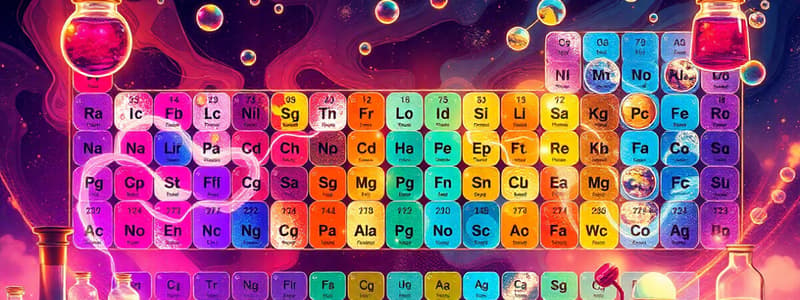Podcast
Questions and Answers
Explain the difference between soluble and insoluble substances, providing one example for each.
Explain the difference between soluble and insoluble substances, providing one example for each.
A soluble substance can dissolve in a solvent, such as salt in water, while an insoluble substance cannot dissolve, like sand in water.
What distinguishes a compound from a mixture at the particle level?
What distinguishes a compound from a mixture at the particle level?
In a compound, the particles are chemically bonded together, while in a mixture, the particles retain their individual properties and can be separated by physical means.
Describe the process of filtration and its purpose in separating mixtures.
Describe the process of filtration and its purpose in separating mixtures.
Filtration involves passing a mixture through a filter to separate solid particles from a liquid or gas, effectively isolating the solid residue from the filtrate.
What are the defining features of chemical changes, and provide two examples?
What are the defining features of chemical changes, and provide two examples?
Explain the roles of solute, solvent, and solution in aqueous mixtures.
Explain the roles of solute, solvent, and solution in aqueous mixtures.
Flashcards are hidden until you start studying
Study Notes
Elements on the Periodic Table
- The Periodic table organizes elements by their atomic number and recurring chemical properties
- Each element has a unique symbol and name
- Elements are the simplest pure substance
- Metals are typically shiny, malleable, ductile, good conductors of heat and electricity
- Non-metals are generally brittle, dull, poor conductors of heat and electricity
Compounds
- Formed when two or more elements chemically combine in a fixed ratio
- Have properties different from the elements that make them up
- Can only be separated by chemical means
Mixtures
- Combinations of two or more substances that are not chemically bonded
- Mixtures can be separated by physical means
- Components retain their individual properties
Elements that Changed the World
- Oxygen: Essential for respiration and combustion
- Nitrogen: Used in fertilizers and explosives
- Silicon: Used in computers and electronics
- Iron: Used in construction and machinery
Compounds that Changed the World
- Water (H₂O): Essential for life and many industrial processes
- Carbon Dioxide (CO₂): Essential for photosynthesis and the greenhouse effect
- Sodium Chloride (NaCl): Used as table salt and in various industrial processes
- Ethanol (C₂H₅OH): Used as a fuel and in alcoholic beverages
Physical and Chemical Changes
- Physical Changes: Alter the form or appearance of a substance but not its chemical composition
- Example: Ice melting into water or cutting paper into smaller pieces
- Chemical Changes: Result in the formation of new substances with different chemical properties
- Example: Burning wood or cooking an egg
Aqueous Mixtures
- A solution is a homogeneous mixture where a solute dissolves in a solvent
- The solute is the substance being dissolved
- The solvent is the substance doing the dissolving, usually water
- Example: Salt water, where salt is the solute and water is the solvent
Soluble and Insoluble
- Soluble substances dissolve in a solvent, forming a solution
- Insoluble substances do not dissolve in a solvent, forming a suspension
Suspensions and Solutions
- Suspensions are heterogeneous mixtures where particles are visible and settle over time
- Solutions are homogeneous mixtures where particles are evenly distributed and do not settle
Gravity Separation and Decantation
- Gravity separation utilizes the difference in density to separate solids from liquids
- Decantation is the process of carefully pouring off the liquid, leaving the solid behind
Filtration
- Filtration uses a porous material to separate solids from liquids
- The liquid passes through, while the solid is retained
Chromatography
- Used to separate components of a mixture based on their different affinities for a stationary and a mobile phase
- The mobile phase carries the components, and the stationary phase retains them based on their properties
Evaporation
- Separates a dissolved solid from a liquid by heating the solution
- The liquid evaporates, leaving the solid behind
Chemical Reactions
- Chemical reactions involve the rearrangement of atoms and molecules
- They can be represented by chemical equations showing reactants and products
- Example: Burning methane gas (CH₄) to produce carbon dioxide (CO₂) and water (H₂O)
Combustion
- A chemical reaction involving a substance rapidly reacting with oxygen, releasing heat and light
- Example: Burning wood or gasoline
Photosynthesis
- The process by which plants use sunlight, carbon dioxide, and water to produce glucose and oxygen
- The chemical equation is: 6CO₂ + 6H₂O --> C₆H₁₂O₆ + 6O₂
Respiration
- The process by which living organisms break down glucose to release energy, using oxygen and producing carbon dioxide and water
- The chemical equation is: C₆H₁₂O₆ + 6O₂ --> 6CO₂ + 6H₂O + Energy
Studying That Suits You
Use AI to generate personalized quizzes and flashcards to suit your learning preferences.




